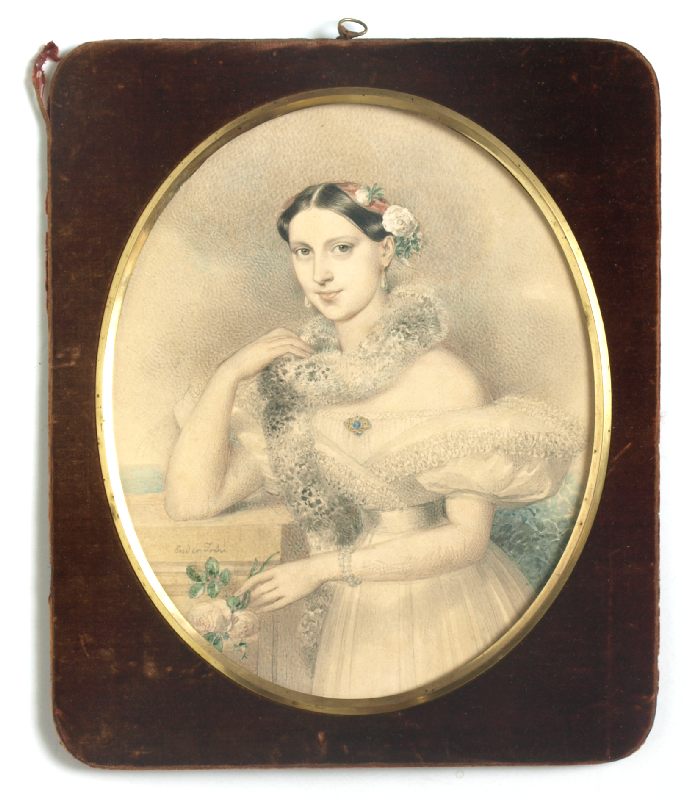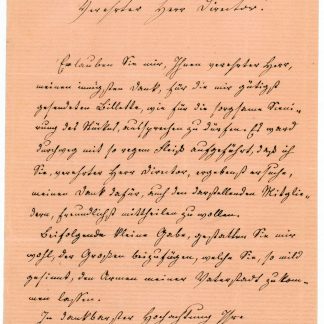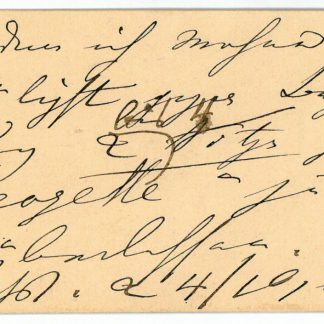An unknown portrait of the 19th-century queen of ballet
Portrait miniature of Fanny Elssler, signed "Ender Joh." at bottom left.
Watercolor in original red satin frame; oval picture space set in gold. 240:200 mm.
€ 18,000.00
Hitherto unknown portrait miniature of the young dancer, painted by the most highly sought-after portraitist of the Viennese Biedermeier period (cf. AKL XXXIII, 531), and probably produced shortly after 1830 - at the time of Fanny's first great success in Vienna and before the birth of her second illegitimate child, to be born in London in 1832.
The half-length portrait shows Fanny Elssler in a strapless white dress with lace trimmings and wide sleeves; an ermine is draped about her neck; her right hand rests upon a pedestal, in her left she holds three roses. Apart from an eye-catching brooch and a pearl necklace, she also wears a white camellia in her hair.
It had been Elssler's later lover Friedrich Gentz (1764-1832) who had sent her four white camellias from his greenhouse on the morning of December 26, 1829 - and on that very evening she was seen wearing one of them in her hair. Her fondness for these precious flowers was to make her known as "la dame aux camélias" (cf. L. Denk, Fanny Elssler. Tänzerin eines Jahrhunderts. Vienna & Munich, 1984, p. 130f.). The political writer Gentz was considered Austria's most important diplomat; as First Secretary, he had led the negotiations at the Vienna Congress. After his death, his close associate Metternich is said to have commented on Gentz's relationship with Fanny Elssler: "Romantic love quickly wears away old men's wits and hastens their end" (cf. Denk, p. 124).
Gentz, who had furnished Elssler's apartment on the Vienna Seilerstätte and maintained it until his death, also commissioned a portrait by Carl Agricola, drawn in the summer of 1830 for the price of 100 fl. and depicting his lady-love in a delicate white dress with low puff sleeves (cf. Denk, p. 150 and fig. 5: "formerly property of Elisabeth Schumann, destroyed during WWI Il", according to Ivor Guest, F. Elssler. Middletown, 1970, p. 17). Although it is known that Elssler sat for Agricola, Waldmüller, Daffinger, and Franz Russ, there is no mention in the relevant literature that J. N. Ender ever painted her, and the present portrait was formerly entirely undocumented.
From the possession of the heirs of Kathi Prinster, Fanny's long-time confidant and companion, to whom the great dancer had bequeathed her "entire effects, including jewels, silver, furniture, wardrobe, shawls, furs, china, glass, etc." (cf. F. Elssler: "Mein letzter Wille" [1884], in: Denk, p. 424f.) from the Seilerstätte apartment they had shared until her death.






